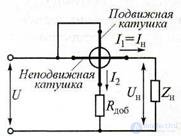Lecture
2.7.1 General Information
In radio engineering, power is measured in almost the entire frequency range, from DC to millimeter and shorter wavelengths. Power levels have to be measured in very wide limits - from 10-18 to 108 W. In recent years, along with absolute (watt, milliwatt, etc.), relative (logarithmic) units of power (decibels) are widely used in measurements. Relative units of measure have a number of significant advantages, they are used to estimate the power of sources of radio-technical signals, the degree of their amplification or attenuation, the sensitivity of receiving devices, measurement errors, etc.
As a physical quantity, electrical power is determined by the work performed by the source of the electromagnetic field per unit of time. The dimension of electric power is recorded as follows: J / s = W.
Power measurement in different frequency ranges has certain features. Power frequency meters along with energy meters are the basis of the current metering system for the consumption of electrical energy in the domestic economy. Measuring power at a constant current, as well as in the range of sound and high frequencies, is of limited importance, since at frequencies up to several tens of megahertz it is often more convenient to measure voltages, currents and phase shifts, and to determine power by calculation. At frequencies above 300 MHz, due to the wave nature of the processes, the values of voltage and currents lose their unambiguity, and the measurement results begin to depend on the connection point of the device. Since the flow of power through any cross section of the transmission line always remains unchanged, power becomes the main parameter characterizing the operation mode of the microwave device.
Active (absorbed by an electrical circuit) powerful single-phase alternating current is determined by the formula:
P = UIcosφ, (2.21)
where U, I - mean square values of voltage and current; φ -
phase shift between their instantaneous values.
If the load RH in the electrical circuit is active (φ = 0), then the AC power.
P = UI = I2 RH = U2 / RH, (2.22)
For an arbitrary waveform having a periodic structure, the electrical power can be estimated using the Fourier series:
Р = UQIQ + U1 I1 соsφ1 + U2I2cosφ2 +… + UnIncosφ, (2.23) where Uo, I0 are constant components; Un, In - mean square values of voltage and current harmonics; φn is the phase shift between the harmonics of the voltage Un and the current In.
AC electrical power can be measured directly using special devices - wattmeters, or indirectly by measuring the values included in the above ratios. The principle of operation of wattmeters is based on the implementation of the multiplication operation. Apply devices of direct and indirect multiplication. Examples of devices for direct multiplication are the measuring mechanisms of wattmeters of an electrodynamic system. Direct multiplication of voltage and current can be achieved using Hall converters, or special schemes on field-effect transistors, etc.
In devices of indirect multiplication, the product of quantities is found by addition (subtraction), exponentiation, logarithmization, integration, etc. For these purposes, analog integral multipliers are used. Modern wattmeters at 1 ... 10 MHz are created on the basis of integral multipliers using thermal converters.
2.7.2 Power Measurement in the Low Frequency Bands
For direct measurements in the frequency range 1 ... 10 kHz, electrodynamic wattmeters are sometimes used.
Electrodynamic wattmeters. The principle of operation of an electrodynamic power meter is based on the fact that the angle of rotation and the frame (with an arrow) of an electrodynamic device is proportional to the product of currents multiplied by the cosine of the angle φ between them:
α = kI 1 I 2cosϕ, (2.24)
where k is a constant for a given instrument coefficient.
Suppose you want to measure the active power consumed by a certain load ZN, to which the mean square value of the voltage Un is applied. Through the load ZH, a harmonic current flows with a mean square value of IH shifted in phase by an angle φ with respect to the voltage. The circuit for switching on the electrodynamic power meter coils is shown in fig. 2.22. If the parameters of the power meter are chosen so that R to 6 >> ZH, then the current in the fixed coil is I1 ≈ IH, and in the moving coil - I2 ≈ UH / Rdob. Therefore, the angle of deviation of the arrow α, taking into account formula (2.25), will be proportional to the active power in the load P:

Figure 2.22 Electrodynamic power meter diagram: RDOB - incremental resistance
α≈ ( kI H UH / R DOB ) cosϕ≈ kP , (2.25)
where k - coefficient of proportionality.
Electrodynamic wattmeters can be used to measure electrical power in both direct and alternating current circuits, but they are most widely used to measure power of industrial frequency.
1. What is the power of electrical oscillations?
2. List the main methods of measuring power in different frequency ranges.
3. Explain the principle of the electrodynamic power meter.
Comments
To leave a comment
METROLOGY AND ELECTROradio-measurement
Terms: METROLOGY AND ELECTROradio-measurement